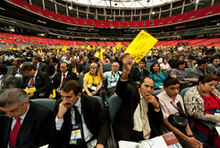24 Jun 2010, Atlanta, Georgia, United States…Edwin Manuel Garcia
Recognizing the booming growth of the global Seventh-day Adventist Church, delegates at the first official business meeting of the 2010 General Conference Session on Thursday agreed to formally reorganize the organizational structure of more than a dozen of its union administrative structures.
Delegates also voted to amend the Constitution and Bylaws in a way that would empower the Session Steering Committee to take up any new business that is not part of the approved Session agenda. The move is expected to prevent individuals or groups from trying to advance last-minute proposals that church leaders may tend to view as controversial.
Having the 40-member Steering Committee vet new issues will also bring more order to the business sessions, said Viesturs Reki, president of the 4,000-member Latvia Conference, who voted in favor of the proposal. At past General Conference Sessions, Reki said, some delegates have risen to speak on unexpected topics, “and it takes away from the main agenda.”
The business session, held on the floor of the Georgia Dome, was mostly devoted to informational updates and instructions to the 1,987 delegates that had so far registered. Votes were unanimous, with delegates raising and waiving yellow placards to indicate their approval for agenda items.
The proposal to reorganize and realign the church structure — formalizing a process that began a year ago for some regions — will mostly affect congregations in Latin America, in areas experiencing rapid growth.
The move approved additional “unions of churches” structures, which allows congregations to relate directly to the union, and eliminating the typical “conference” administration. This is already found in a few areas with smaller membership.
Some of the changes, approved unanimously, include:
-Reorganizing the former Austral Union Conference into a union conference and two unions of churches missions — the Argentina Union Conference, the Paraguay Union of Churches Mission, and the Uruguay Union of Churches Mission.
-Splitting the former North Brazil Union Mission into two entities — the North Brazil Union Mission and the Northwest Brazil Union Mission.
-Approving the North Philippine Union’s switch from “mission” to “conference” status, meaning the region is now financially and administratively self-supporting.
The approval of the changes at General Conference Session grants official status to the management realignments. However, many of the regions have been operating under the changes since introduction at previous meetings of the Executive Committee following the last General Conference Session in 2005.
“The recognition of Paraguay, Uruguay and Argentina … signifies a historic moment for the church,” said Carlos Gill, president of the year-old Argentina Union.
Gill and other leaders said the formal recognition will allow membership to grow even faster in their respective regions, and give the union executives a seat on the General Conference bodies that make decisions for the global church.
The reorganization established a fourth union in Mexico, known as the Central Union; the former North Central American Union, meanwhile, was split into the Guatemala and Belize unions.
“The church is growing so much that we need to establish new unions and local fields to tend to that growth,” said Juan Perla, the secretary for the region that includes Mexico, Central America, the Caribbean and the northern section of South America. “We are extremely pleased to know that they are now officially recognized.”
